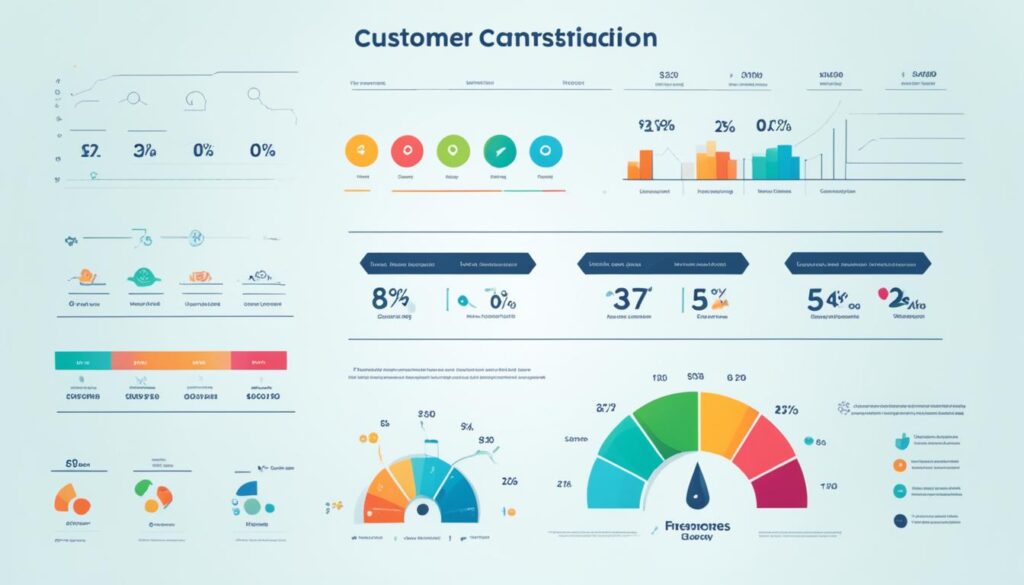Welcome to our article on customer experience metrics, where we explore the essential tools for boosting sales and enhancing customer satisfaction. As a business, understanding how customers perceive and interact with your brand is crucial for success. By measuring customer experience metrics, you can gain valuable insights into areas of improvement and prioritize your CX strategies.
Customer satisfaction metrics, customer journey metrics, customer loyalty metrics, customer feedback metrics, and customer retention metrics are all vital components of a comprehensive CX strategy. These metrics provide valuable data that helps you gauge the effectiveness of your efforts and make informed decisions.
In the following sections, we will delve into some of the key customer experience metrics that you should be measuring to optimize your CX strategy and drive sales. Let’s explore the Net Promoter Score (NPS), customer satisfaction (CSAT), customer effort score (CES), first response time (FRT), average resolution time (ART), and customer churn rate and retention rate.
Net Promoter Score (NPS)
The Net Promoter Score (NPS) is a widely-used metric for measuring customer loyalty. It allows you to gauge how likely your customers are to recommend your company or its products/services to others. By asking customers a simple question, “On a scale of 0-10, how likely are you to recommend us?”, you can categorize them into one of three groups: detractors, passives, or promoters.
Detractors are customers who score between 0-6 and are unlikely to recommend your brand. Passives fall within the 7-8 range, indicating indifference towards recommending your business. Promoters, on the other hand, score 9-10 and are highly likely to promote your brand to others.
An NPS survey provides actionable insights into customer loyalty and plays a crucial role in identifying areas for improvement. It is beneficial to administer these surveys shortly after acquiring new customers and throughout their entire journey with your brand. By monitoring and analyzing NPS, you can gain valuable insights into customer sentiments and make informed decisions to enhance customer loyalty.
The Net Promoter Score is a powerful tool that not only helps you measure customer loyalty but also allows you to identify brand promoters who can generate positive word-of-mouth and contribute to your business growth.
Customer Satisfaction
When it comes to keeping your customers happy, measuring customer satisfaction is essential. Customer satisfaction (CSAT) surveys allow you to gauge how satisfied your customers are with your products or services. By asking them to rate their experience on a scale of 1-5 or 1-10, you can gather valuable feedback to improve your offerings.
CSAT scores can be calculated by averaging the percentage of positive survey responses. This metric provides a tangible measure of your customers’ satisfaction levels, helping you identify areas for improvement and prioritize your efforts. Conducting CSAT surveys after specific touchpoints or interactions can pinpoint exactly where you need to enhance your customers’ experience.
By continuously monitoring customer satisfaction metrics, you can stay proactive in meeting your customers’ expectations and ensuring their loyalty. Improving customer satisfaction not only leads to happy and loyal customers but also boosts your brand’s reputation and competitiveness in the market.

“Customer satisfaction is the foundation of customer loyalty and brand advocacy. By measuring and analyzing customer satisfaction metrics, businesses can identify areas for improvement and take targeted actions to enhance the overall customer experience.”
When it comes to boosting customer satisfaction, remember to listen to your customers’ feedback and take actionable steps based on their insights. It’s not just about meeting their expectations but exceeding them.
- Retain a personalized approach to customer interactions.
- Always strive to go above and beyond in delivering exceptional service.
- Identify pain points in your customers’ journey and work towards eliminating them.
- Regularly communicate with your customers to ensure their needs and expectations are being met.
Remember, satisfied customers are more likely to become loyal advocates for your brand, recommending your products or services to others. By prioritizing customer satisfaction metrics, you can cultivate a strong customer base and drive long-term success for your business.
Customer Effort Score (CES)
Customer effort score (CES) is a crucial customer experience metric that measures the level of effort customers experience when using a product/service. It helps businesses gauge customer loyalty and satisfaction by evaluating the ease of their interactions. CES is measured on a scale ranging from very difficult to very easy, providing insight into customer engagement and the overall customer experience.
Identifying areas where customers may face challenges or unnecessary effort is essential for improving the customer journey. CES surveys can be conducted after an interaction with customer service or after using a product/service to gather valuable feedback. By understanding the pain points and frustrations customers encounter, businesses can prioritize efforts to enhance usability and reduce customer effort, thus increasing customer satisfaction and loyalty.
Why is CES Important?
CES plays a vital role in understanding customer satisfaction and engagement metrics. By focusing on minimizing customer effort, companies can cultivate a positive experience that encourages loyalty and repeat business. When customers find it easy to accomplish their goals and navigate through interactions, they are more likely to stay engaged with the brand and recommend it to others.
“By reducing customer effort and streamlining the user experience, businesses can increase customer engagement, decrease churn, and ultimately boost revenue.”

Implementing CES surveys not only helps identify areas for improvement but also enables businesses to proactively address customer pain points. By integrating customer feedback into product/service enhancements and process optimizations, businesses can provide a seamless and effortless experience for their customers.
- Benefits of tracking CES:
- Identify customer pain points
- Improve customer satisfaction and loyalty
- Enhance overall customer experience
- Reduce customer churn and increase retention
- Drive positive word-of-mouth referrals
By consistently monitoring and improving CES, businesses can align their CX strategies with customer expectations and preferences. This allows companies to stay ahead of the competition and deliver an exceptional experience that keeps customers engaged, satisfied, and loyal.
First Response Time and Average Resolution Time
In the world of customer support metrics, two crucial factors determine the effectiveness and efficiency of your customer service operations: First Response Time (FRT) and Average Resolution Time (ART). These metrics play a vital role in enhancing customer satisfaction, loyalty, and brand image.
First Response Time (FRT) measures the speed at which a customer receives the first response from your customer support team after submitting a query or issue. When customers reach out for assistance, they expect a prompt and helpful response. A quick FRT demonstrates your commitment to addressing customer concerns promptly, ensuring they feel valued and heard. Remember, the longer they wait, the more frustrated they may become. Aim to minimize FRT to provide a superior customer experience.
Average Resolution Time (ART) evaluates the duration it takes for customer support teams to resolve individual support requests. Customers appreciate a swift resolution to their problems, as it demonstrates your team’s competence and dedication to helping them. By monitoring and improving ART, you can effectively optimize your support processes, exceed customer expectations, and foster long-term customer loyalty.
Implementing efficient systems and providing comprehensive training to your support team can significantly impact FRT and ART. Remember, every interaction with your customers is an opportunity to build trust and strengthen relationships. Prioritizing these customer support metrics will undoubtedly contribute to your overall customer satisfaction and brand success.

Customer Churn Rate and Retention Rate
Customer churn rate and retention rate are vital metrics for businesses to analyze and assess their customer base. Churn rate measures the percentage of customers who decide not to renew their contracts or cancel their subscriptions. On the other hand, retention rate represents a business’s ability to retain and keep customers over time. These metrics are essential for forecasting growth and identifying areas that require customer marketing and retention activities.
Monitoring customer churn rate can provide valuable insights into the effectiveness of your customer retention strategies. When the churn rate is high, it indicates that there may be issues with product satisfaction, customer service, or overall customer experience. By analyzing and addressing these areas, businesses can improve their customer retention metrics and build long-term loyalty.
Retention rate, on the other hand, measures the success of your customer retention efforts and reflects your brand’s ability to keep customers engaged and satisfied. A high retention rate indicates that customers are loyal, engaged, and emotionally connected to your brand. This not only leads to recurring revenue but also positive word-of-mouth recommendations and a strong brand reputation.
By regularly tracking and improving customer churn rate and retention rate, businesses can proactively address potential customer attrition and focus on strategies that foster customer loyalty and satisfaction. Recognizing the importance of these customer retention metrics is crucial for sustained business growth and long-term success in a highly competitive market.
FAQ
What are customer experience metrics?
Customer experience metrics are measures used to evaluate the success of a brand’s customer experience strategy. These metrics help identify areas for improvement and prioritize improvement strategies.
What is the Net Promoter Score (NPS)?
The Net Promoter Score (NPS) is a widely-used metric for measuring customer loyalty. It determines how likely customers are to recommend a company or its products/services to others. NPS surveys provide actionable insights for customer acquisition and throughout the customer journey.
How is customer satisfaction measured?
Customer satisfaction (CSAT) is measured through surveys that ask customers to rate their experience on a scale. These surveys provide feedback on customer satisfaction and help identify areas for improvement.
What is the Customer Effort Score (CES)?
The Customer Effort Score (CES) measures the level of effort customers experience when using a product/service. It helps gauge customer loyalty and identifies areas where customers face challenges or unnecessary effort.
What do First Response Time and Average Resolution Time measure?
First Response Time (FRT) measures the time it takes for customers to receive the first response from a customer support team. Average Resolution Time (ART) measures the average time to resolve customer support requests. Monitoring and improving these metrics can enhance customer satisfaction and brand image.
What are churn rate and retention rate?
Churn rate measures the percentage of customers who do not renew or cancel their contracts, while retention rate measures a business’s ability to keep its customers over time. These metrics are important for forecasting growth and identifying areas for marketing and retention activities.
